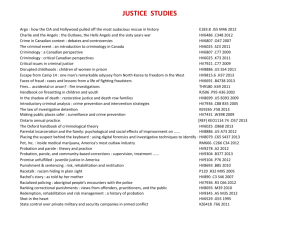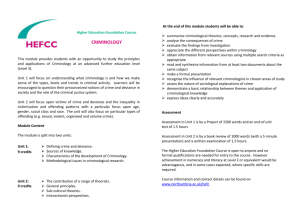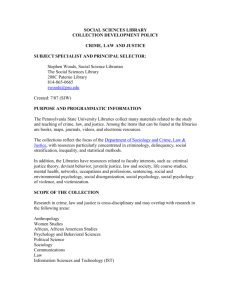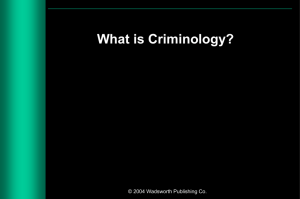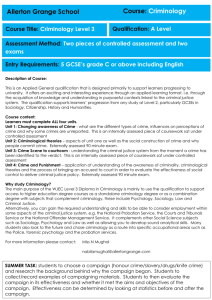CRIMINOLOGY 2002
advertisement
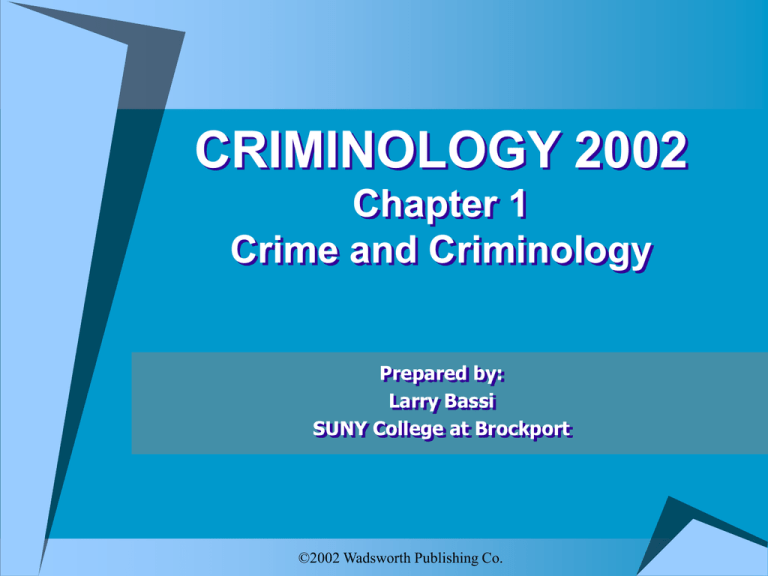
CRIMINOLOGY 2002 Chapter 1 Crime and Criminology Prepared by: Larry Bassi SUNY College at Brockport ©2002 Wadsworth Publishing Co. Historical Roots of Criminology Utilitarian philosophy of Becarria Positivism Biological determinism of Lombroso Sociological theory of Durkheim and Quetelet Conflict Criminology of Marx Ch. 1 - Slide 2 What is Criminology? Criminology is the scientific approach to: a. the study of criminal behavior and, b. society’s reaction to law violations and violators Ch. 1 - Slide 3 The Criminological Enterprise Crime Statistics Sociology of Law Theory Construction Criminal Behavior Systems Penology Victimology Criminology Ch. 1 - Slide 4 Perspectives in Criminology Perspective: The relationship of aspects of a subject to each other and to a whole: a point of view. Ch. 1 - Slide 5 Criminology Perspectives CLASSICAL/ CHOICE BIOLOGICAL/ PSYCHOGICAL STRUCTURAL PERSPECTIVES Situation forces Crime is a function of free will and personal choice Punishment is a deterrent to crime. Internal forces Crime is a function of chemical, neurological genetic, personality, intelligence, or mental traits. Ecological forces Crime rates are a function of neighborhood conditions, cultural forces, and norm conflict. Socialization forces PROCESS Crime is a function of upbringing, learning, and control. peers, parents, and teachers influence behavior. Economic and Political forces CONFLICT Crime is a function of competition for limited resources and power. Class conflict produces crime. Multiple force INTEGRATED Biological, social-psychological, economic and political forces may combine to produce crime. Ch. 1 - Slide 6 Deviancy or Criminality? Deviant Behavior Is an action that departs from the social norms of society. Deviant Behavior becomes criminal behavior when it is specifically defined prohibited and punished under the criminal law. Ch. 1 - Slide 7 Differing Views on the causes and controls of criminal behavior Consensus View •Law defines crime •Agreement exists on outlawed behavior •Laws apply to all citizens equally Ch. 1 - Slide 8 Differing Views on the causes and controls of criminal behavior Conflict view •Law is a tool of the ruling class •Crime is a politically defined concept •“Real crimes” are not outlawed •Law is used to control the underclass Ch. 1 - Slide 9 Differing Views on the causes and controls of criminal behavior Interactionist view •Moral entrepreneurs define crime •Crimes are illegal because society defines them that way •Criminal labels are lifetransforming events Ch. 1 - Slide 10 Crime is a violation of societal rules of behavior as interpreted and expressed by the criminal law, which reflects public opinion, traditional values and the viewpoint of people currently holding social and political power. Individuals who violate these rules are subject to sanctions by state authority, social stigma, and loss of status. Ch. 1 - Slide 11 Origins of the Law Code of Hammurabi Mosaic Code Wergild Common Law Ch. 1 - Slide 12 Social Goals of Criminal Law Expressing public opinion and morality Maintaining social order Discouraging Revenge Punishing Wrongdoing Enforcing Social Control Deterring Criminal Behavior Ch. 1 - Slide 13 Principles of Criminal Law Legality Harm Concurrence Actus Reus Mens Rea Causation Punishment Ch. 1 - Slide 14 Doing Criminology: Types of Research Survey Research (cross-sectional research) Longitudinal Research (cohort groups) Experimental Research Aggregate Data Research Observational Research Ch. 1 - Slide 15 Ethics in research! Political and social consequences of criminological research must be considered. What standards should apply? Who should set the standards? Ch. 1 - Slide 16


